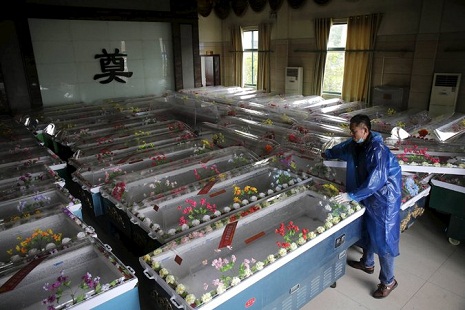At least two vessels, a cruise ship and a ship that transported cars, stopped their upstream journeys, dropping their anchors into the shallow, muddy water.
But the Oriental Star sailed on. Time-stamped video footage captured by a camera on another vessel shows the cruise ship — with four tiers of brightly lit cabins — heading into the darkness and driving rain about 33 minutes before it capsized. Two days later, only 14 people among the 456 aboard have been found alive.
The government has detained Mr. Zhang but said nothing about how he had escaped the ship alive or whether he had radioed for help, warned passengers to don life vests or ordered an evacuation.
As Chinese officials provided little new information about the cause of Monday’s accident, saying that a rare tornado had overwhelmed the cruise ship, questions also emerged about the seaworthiness and safety record of the Oriental Star.
In an interview, Yan Zhiguo, a director of the company that owns the ship, acknowledged that the hull of the Oriental Star was modified in 1997, an adjustment that could have altered its center of gravity and made it more susceptible to tilting over. And a former member of the ship’s crew said that its furniture was not bolted down, allowing weight on the ship to shift more easily in rough waters and making it more vulnerable to capsizing.
The Oriental Star was one of six vessels cited in 2013 for unspecified violations as part of an effort to improve the safety of ships on the Yangtze River, according to a document on the website of the Jiangsu Maritime Safety Administration.
It is not clear if the government’s storm alert made it to the Oriental Star, and Chinese regulations are vague about whether ships must anchor or pull into a port when warned of dangerous weather. Captains are granted broad authority over their vessels in China, as elsewhere in the world. Still, some interviewed said that Mr. Zhang should have heeded the weather warning and stopped his ship.
“Under very low visibility due to a strong rainstorm, captains should stop the boat,” said Cai Cunqiang, a professor at the Shanghai Maritime University Merchant Marine College and a former merchant marine captain. “Captains who have been alerted will stop when there are strong rainstorms. But it is not clearly stated in law that captains must stop.”
“It’s safer to anchor than to keep moving,” he added.
Other ships did stop, and they made it through the storm. One cruise ship, the Yangtze Sightseer No. 6, which the Oriental Star had trailed for days, anchored around 9:10 that night, about six miles ahead of the scene of the disaster, according to a satellite tracking system overseen by the Ministry of Transport and a passenger reached by telephone.
The passenger, who asked to be identified by only his surname, Liao, said the Sightseer had encountered “strong winds, heavy rain and thunder and lightning” before anchoring. “A lot of water was blown inside,” he said. “On the second floor, our attendants were all trying to scoop the water out.”
The captain of another ship, the Changhang Jiangning, a large cargo vessel that transports automobiles, chose to drop anchor and wait out the storm just as it was being overtaken by the Oriental Star, according to a state newspaper, The Chutian Metropolis Daily.
The satellite tracking data shows the vessel stopping at 9:19 p.m. and holding that position for about an hour. When it stopped, according to the data, the Oriental Star was less than 200 yards away.
Minutes later, the cruise ship changed direction, moving downstream instead of upstream, apparently after being hit by what the authorities say was a tornado. The last signal from the Oriental Star was recorded at 9:31 p.m.
“The captain alone has the absolute authority to decide how to deal with emergencies,” said Xue Yingchun, a ship captain who started his own shipping company. “In inland navigation, you can drop the anchor any time you want since the water is normally not too deep.”
Stephen Richter, a ship’s pilot and marine consultant in Philadelphia, said that anchoring makes sense in situations of low visibility and heavy rain, which reduces the usefulness of a ship’s radar. “If the weather was that extreme, then visibility becomes an issue, then probably the safest thing to do is to anchor,” he said.
More about:
















































